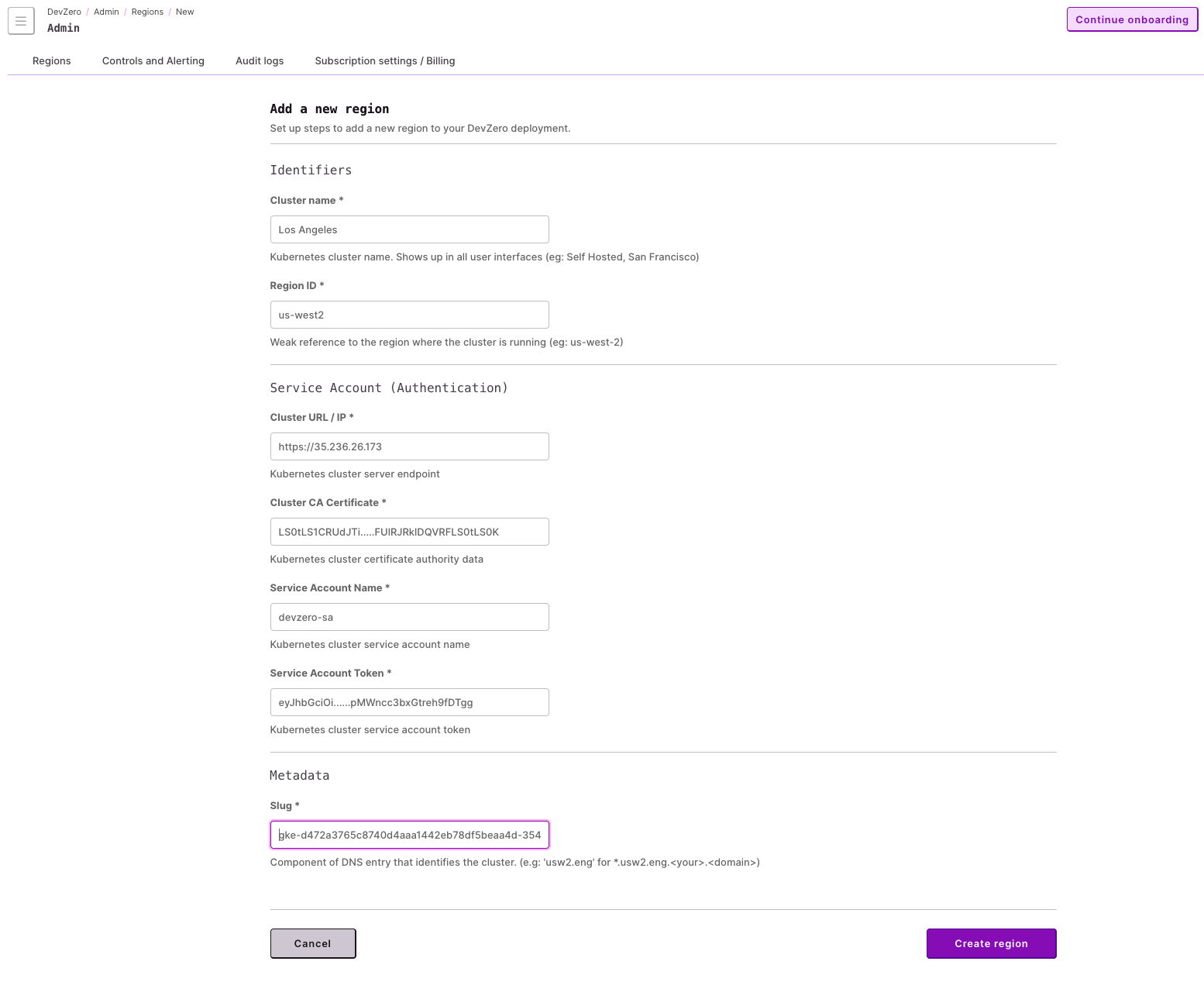Data Plane
Self-hosting a DevZero Data Plane on AWS EKS.
Hosting the DevZero Data Plane on AWS EKS
For a detailed overview of the DevZero Data Plane, click here
Prerequisites
Prerequisites and requirements for this doc are the same as AWS Setup.
Deploying the data plane
Clone devzero-inc/self-hosted
git clone https://github.com/devzero-inc/self-hosted.git
cd self-hostedContact DevZero Support if you don't have access to the repository.
Set up kubeconfig
Set up your local kubeconfig to connect to the EKS cluster using the region and cluster name from the terraform output:
aws eks update-kubeconfig --region <region> --name <cluster-name>Set up data plane dependencies
Go to the charts/dz-data-plane-deps directory to modify configurations before running any installation steps.
cd charts/dz-data-plane-depsIf you are using private subnets and traffic is routed through a VPN, add this and replace <private_subnet_1> and <private_subnet_2>:
Change data-plane-deps domains from example.com to where DevZero will be hosted (e.g.: devzero.companyx.com)
# in: charts/dz-data-plane-deps
# change example.com to devzero.companyx.com in all files in the values/ directory
find values -type f -exec sed -i'.bak' 's/example\.com/devzero\.companyx\.com/g' {} \; && find values -name "*.bak" -deleteInstall data plane dependencies
# in: charts/dz-data-plane-deps
make installChange data-plane domains from example.com to where DevZero will be hosted (e.g.: devzero.companyx.com)
# in: charts/dz-data-plane-deps
cd ../dz-data-plane
# in: charts/dz-data-plane
find . -name "values.yaml" -exec sed -i'.bak' 's/example\.com/devzero\.companyx\.com/g' {} \; && find . -name "values.yaml.bak" -deleteInstall data plane
# in: charts/dz-data-plane
make installSetup ingress and connect to AWS Route 53
Get the ingress service in the cluster
kubectl get service -n devzero-data-ingressAlternatively, run:
kubectl get svc -n devzero-data-ingress -o jsonpath='{.items[?(@.spec.type=="LoadBalancer")].status.loadBalancer.ingress[*].hostname}'Copy the address of your ingress services.
Create a CNAME record. Set the name to *.usw2.eng. Set the value to the address of the ingress service (copied from previous step).
For the wildcard name in the CNAME record, we suggest following *.<REGION>.<DOMAIN> (e.g.: *.usw2.eng).
You will need this in the Slug section for connecting this data plane to the control plane.
Connecting to DevZero control plane
Connect the data plane to the DevZero control plane
Visit the regions page on the DevZero dashboard and click Add New.
For a self-hosted deployment of the control plane, go to https://devzero.companyx.com/dashboard/organization-settings/regions.

Use the retrieved values (token, URL, and CA certificate) to connect the
self-hosted DevZero region to your team: 
Fetching Cluster Configuration
After deploying the Helm chart, retrieve the following values for integration with the DevZero dashboard:
Cluster Name
Enter something meaningful and unique.
Examples: Frankfurt (eu-central-1), Mumbai (ap-south-1), N. California (us-west-1), São Paulo (sa-east-1)
Region ID
Enter a cloud-friendly region name (does not necessarily have to be unique).
To preserve familiarility, feel free to reuse existing GCP terms. For a list of AWS Region Names, click here.
Examples: ap-south-1 (Mumbai), eu-central-1 (Frankfurt), sa-east-1 (São Paulo), us-west-1 (N. California)
Cluster URL
To get the Cluster URL/IP:
kubectl config view --minify --raw -o jsonpath='{.clusters[0].cluster.server}'For example,
% kubectl config view --minify --raw -o jsonpath='{.clusters[0].cluster.server}'
https://35.236.26.173Add the string as is, without leading or trailing whitespaces.
Cluster CA Certificate
To get the Cluster CA certificate:
kubectl config view --minify --raw -o jsonpath='{.clusters[0].cluster.certificate-authority-data}'For example,
% kubectl config view --minify --raw -o jsonpath='{.clusters[0].cluster.certificate-authority-data}'
LS0tLS1CRUdJTi.....FUlRJRklDQVRFLS0tLS0KAdd the string as is, without leading or trailing whitespaces.
Service Account Name
To get the name of the Service Account:
kubectl get serviceaccounts -n devzero-self-hostedUsually, this should be devzero-sa.
Add the string as is, without leading or trailing whitespaces.
Service Account Token
To get the Service Account Token:
kubectl get secret devzero-sa-token -n devzero-self-hosted -o jsonpath='{.data.token}' | base64 -dFor example,
% kubectl get secret devzero-sa-token -n devzero-self-hosted -o jsonpath='{.data.token}' | base64 -d
eyJhbGciOi......pMWncc3bxGtreh9fDTggAdd the string as is, without leading or trailing whitespaces.
Slug
Set any memorable value for the slug (ideally the same name you see in the AWS Dashboard).
Take name of the CNAME record from the Setup ingress and connect to AWS Route 53 section.
If the name was *.usw2.eng, set Slug to usw2.eng.
